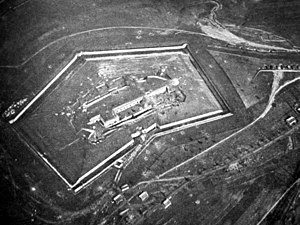Séré de Rivières system
| Séré de Rivières system | |
|---|---|
| Part of frontier and coast defences | |
| France | |

Aerial photograph of Fort de Douaumont, Verdun, 1916
|
|
| Coordinates | 46°00′N 02°00′E / 46.000°N 2.000°ECoordinates: 46°00′N 02°00′E / 46.000°N 2.000°E |
| Site information | |
| Owner | La Troisième République (French Third Republic) |
| Operator |
Comité de Défense 1872–1888 Conseil Supérieur de la Guerre 1888–1918 |
| Site history | |
| Built | 1874 |
| Battles/wars | First World War Battle of the Frontiers Battle of Verdun |
| Garrison information | |
| Occupants | French Army |
The Séré de Rivières system was named after Raymond Adolphe Séré de Rivières, its originator. The system was an ensemble of fortifications built from 1874 along the frontiers and coasts of France. The fortresses were from the beginning of the First World War.
Following the Franco-Prussian War of 1870–1871, France found itself seriously weakened and isolated from the rest of Europe, menaced by Germany and stung by the loss of Alsace-Lorraine. At the same time as the departure of the last German troops, France created the "Defense Committee" (Comité de Défense), active between 1872 and 1888, whose mission was to reorganize the defense of the French frontiers and coastals. It was necessary to compensate for the lost territories of the north-east, to modernize old fortifications which had been shown to be wanting in the last war and to create new fortifications adapted to new combat techniques. The greatly improved effectiveness of artillery in the new age demanded new measures.
The committee was created by a Presidential decree on 28 July 1872, with nine members from the Ministry of War and representatives from artillery and military engineering. General Séré de Rivières, commander of engineering for the Second Army Corps of Versailles, was named secretary of the committee in 1873 and on 1 February 1874 was promoted to Chief of Engineers. During the ensuing years, Séré de Rivières was re-elected head of the committee with all powers necessary to realize his ideas without opposition. The first works of the new French fortification system were begun in 1874. In 1880, when the work was already quite advanced and after some internal rivalries and political machinations, General Séré de Rivières was removed from the Defense Committee but the work continued.
Since the fortifications executed by Vauban in the seventeenth century, defensive technology had not evolved during the course of the 19th century. During the Franco-Prussian War, their shortcomings became clear, the "impregnable citadel" could no longer resist assault. It was necessary to re-think strong points and adapt them to the progress of artillery. Gone were citadels surrounding towns, forts were to be moved outside cities some 12 km (7.5 mi) to keep the enemy beyond artillery range of the city center. Rings of forts were to be built at a spacing that would allow them to cover the intervals between them. The new forts abandoned the principle of the bastion, which had also been made obsolete by advances in arms. The outline was a much simplified polygon, surrounded by a ditch that was covered by caponiers. These forts, built in masonry and shaped stone, were designed to shelter their garrison against bombardment and artillery was laid out on top of the fort in the open air. A feature of the new system involved the construction of two defensive curtains, an outer line of forts, backed by an inner ring or line of forts d’arrêt at critical points of terrain or junctions, along with great number of coastal batteries. Examples of the first sort may be found at Verdun, Toul, Épinal, Belfort in the north-east, as well as Paris and Brest. Forts d'arrêts may be found at Manonviller, (Meurthe-et-Moselle) et de Bourlémont (Vosges).
...
Wikipedia
